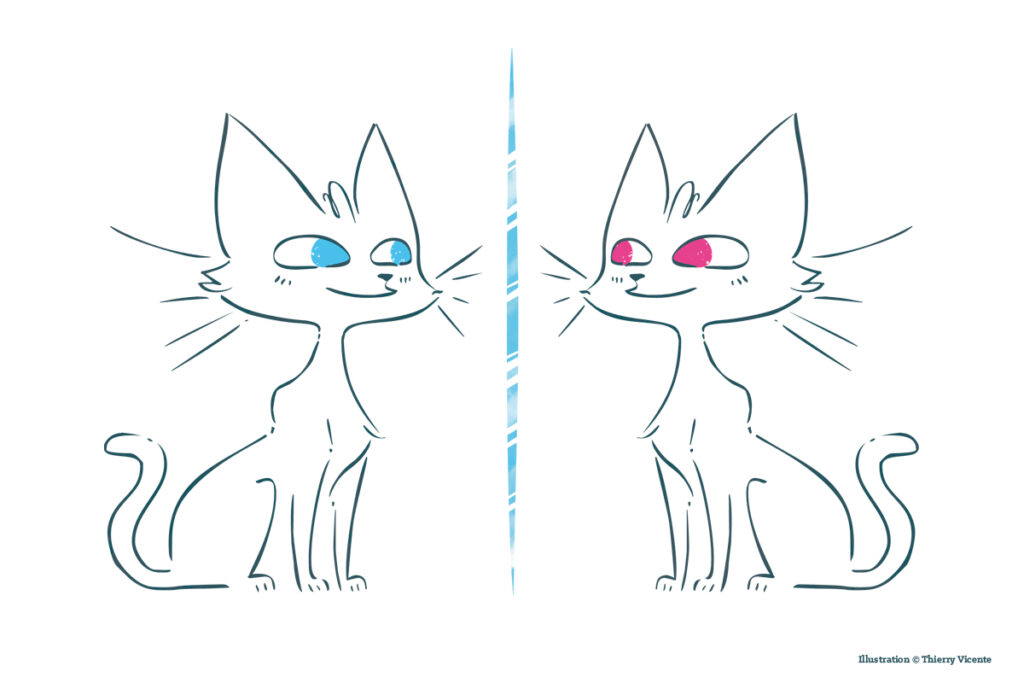[LUM#8] The hidden life of our genes
While genetics is the study of genes, epigenetics is concerned with how these genes are expressed. This promising discipline opens up new horizons for medical research.

In 2001, a kitten like no other made headlines around the world. His name: carbon copy. What made it special? This ball of fur is a clone. It has exactly the same genetic make-up as the cat from which it was born. But what's not so obvious is that, while the two felines have exactly the same DNA, they don't have the same coat. How can two clones carrying the same genes be so different? " Heredity can't be reduced to our genes alone, because DNA doesn't carry all the information," replies Giacomo Cavalli. This is the key to this surprising difference in fur: epigenetics.
Epigenetics is the study of changes in gene activity that are not linked to changes in the DNA sequence. " Gene function depends not only on the primary sequence, but also on a number of modifications to the chromosome," explains the researcher from the Institute of Human Genetics(IGH). These modifications correspond to biochemical marks applied by specialized enzymes to DNA, or to proteins called histones, which are responsible for compacting DNA so that it can be housed in the cell nucleus. The same genome can therefore express itself differently according to epigenetic modifications (see box).
Identical but different
While these modifications play a major role during embryonic development, they also occur throughout life, notably under the influence of the environment: what we eat, what we drink, the products to which we are exposed, all trigger epigenetic modifications that affect our biology... and perhaps that of our descendants too. " Epigenetics is an inheritance mechanism that adds to genetic inheritance ", explains Frédéric Bantignies of the IGH.
The two researchers have discovered a new mechanism of epigenetic inheritance in Drosophila. By modifying the chromosome structure at the level of the genes that produce eye pigments, they obtained flies with strictly the same DNA, but with variable eye color. They then observed the offspring of these Drosophila and found that this change in eye color was passed on to their offspring.
Are the epigenetic changes we carry also passed on to our children and grandchildren? This is what some population observation studies suggest, such as that of the "Dutch Mothers", a group of pregnant women exposed to famine during the Second World War. Undernourished, these women gave birth to low-weight babies. Once the famine was over, these children grew up on a normal diet, yet when they had children of their own, they gave birth to low-weight babies. " The effects of undernutrition on these women were passed on to their grandchildren, even though they do not affect the DNA sequence, so these are epigenetic modifications ", explains Giacomo Cavalli.
Therapeutic hope
Are we then shaped by the behaviors of our grandparents and the epigenetic modifications induced by their environment? " In reality, it seems that very few of these epigenetic modifications are passed down through the generations, and we still don't know how," answers Frédéric Bantignies. " It's a whole area of hereditary mechanisms that remains unknown ", adds Giacomo Cavalli.
It also opens up a whole new field of medical research. " Epigenetic modifications play a role in the development of certain diseases such as obesity, diabetes and cancer ", explain the researchers. Unlike phenomena that affect the genome, these epigenetic variations can be "erased" by chemical treatments, offering the hope of new treatments. " Epigenetic drugs are already being tested to treat certain cancers ," the researchers add. Epimedicines that may one day enable us to treat diseases against which we are currently powerless.
At the heart of our cells
Each cell in our body contains our entire genetic heritage in its nucleus: 46 chromosomes on which there are some 25,000 genes. A gene is a segment of DNA that contains the information needed to synthesize the molecules that make up the organism. But for this synthesis to take place, the gene must be legible. This is where epigenetic modifications come in: by placing biochemical marks on the DNA, they can alter the gene's legibility, and thus modify its expression. This is one of the reasons why all our body's cells - which all have the same genome - are not alike. A skin cell, for example, differs from a neuron, which in turn has different functions to a heart cell, even though they share strictly the same DNA.
UM podcasts are now available on your favorite platforms (Spotify, Deezer, Apple podcasts, Amazon Music...).